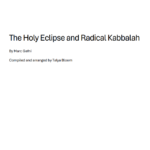A Teaching on Love
Life as Practice and the Three Stations of Love
The evolution of states and stages of consciousness are explicitly discussed in the great traditions. We are using the terms states and stages in the classic sense that they are defined in integral theory. By states then, we refer to experience of expanded or altered forms of awareness. These states are not permanent or stable levels of awareness, but are induced through various means, including but not limited to, spiritual practice. By stages of consciousness, we refer to stable levels of development which take place within the interior of an individual or culture, and which refer to stable achievement of new levels of consciousness. An example of stages of consciousness might be the evolution from pre- personal — personal to transpersonal or in a second example from ego to ethno- to world to kosmocentric consciousness. In this latter example, at every ascending level of consciousness there is an expanded sense of both awareness and identity. A second example might be the six to ten structure stage of interior consciousness within the life of the collective and the individual that are described in many developmental systems, one example of which is the Spiral Dynamics theory of Clare Graves.
States Stages and Stations.
Virtually all the mystical traditions have significant explications of evolving states of awareness. The adept becomes more aware of his or her true nature, more clarified and subtle in relation to the traps of the mind as well as to ever deepening and expanding fields of consciousness. Some of the great traditions also have some significant awareness of evolving stages of consciousness. For example, there are powerful passages in Kabbalist Abraham Kuk, explicitly describing the evolution from egocentric to ethnocentric to world centric to kosmocentric. However, there is generally very little awareness in the traditions of how the teachings of the tradition themselves are refracted through the different structure stages of consciousness.
Station/Phases are a third expression of the evolution of consciousness that is recognized in the Great traditions and is a key dimension of developmental theory. These three stations/phases describe the mechanism for ascending movement from lower to higher structure stages of consciousness. They are also a core map of the evolution of consciousness and the evolution of love — for every growing individual- within whatever structure stage of development they might be at —even if they never leave their particular level of consciousness.
In our second Integral Spiritual Experience, we will unpack what station/phases mean in the context of the great traditions, and we will relate that understanding to developmental theory and explicitly integrate stations/phases into the map of Integral Consciousness.
Before we go further in our explanation of station/phases, we need to note that evolution to higher stages, states and stations of consciousness always takes place in two major ways.
The first engine for the evolution of consciousness within the individual is formal spiritual practice. The second engine is what we will refer to as Life as Practice.
Life as practice describes a profound engine of human transformation which is a key lodestone in what might be termed an emergent World Spirituality. The core recognition is that life itself —with its agony and ecstasy, with its rich textures of love, joy, loss and pain, catalyzed a profound process of deepening within the individual that effects clear and substantive evolution of both states, stages and stations of consciousness.
To cite but a simple example the experience of either powerful love or betrayal might affect a significant evolution in available states, stages and station/phases of consciousness.
At this point we will unpack the notion of station/phases of consciousness in the great traditions using a particular example from the great tradition of Kabbalah.
The Baal Shem Tov, the great Hebrew mystics who founded the Hasidic movement, in a number of elliptical passages discusses what he calls three distinct points in every dimension reality. He refers to them as Hachna’ah, submission, Havdalah, separation and Hamtaka, Sweetness. Read carefully from the inside, it becomes clear that this is a great tradition version of station/phases of consciousness. Each of these three station/phases refers to a distinct experience of consciousness. The stations of consciousness are ascended in a number of ways, but it is primarily through life as practice.
A deep reading of the various passages on submission, separation and sweetness reveals the understanding that these station/phases as described by the Baal Shem Tov are not entirely dis-similar to what the developmentalists might refer to as identification, dis-identification and integration, or from another perspective pre-personal, personal and transpersonal.
The application of these levels applies is relevant in virtually every sphere of human life. They describe three particular station/phases of consciousness, which an awake person evolves through in virtually every sphere of life. Each station/phase transcends and included the previous level. Level three and level three generally appear — to the untrained eye of the outside observer- to be fairly similar in form and structure. However, when experienced from their interior face, it becomes apparent that station one and are entirely different in feeling tone and inner consciousness with only apparent external similarity of the most rudimentary form.
When we apply this core model from the great traditions to love, what emerges is what I have termed the three stations of love.
Part Two:
Three Stations of Love
The Evolution of love moves through three distinct station phases: submission, separation and sweetness. Or said differently one might say that love follows a developmental arc of identification, dis-identification, and integration.
Each developmental stage has different feeling states, different developmental outcomes, and different imperatives for behavior e.g.
Learning to recognize what station/phase you are in is essential to loving fully.
Overview: Baal Shem Tov {Great Traditions} and Robert Keegan {Developmentalist}
3 Stations Applied to Love
Station -Phase One of the Baal Shem Tov:
Submission- Hakna’ah:
The level at which you are subject to something larger like your family, community or tribe. Your identity is established through its absorption in larger framework of experience, affiliation or meaning. At this level you “submit” to or are embedded in a certainty. You are in an experience of fusion. One expression is that of falling in love. You are submitting to a larger current or force moving through you.
Application to Love: Falling in Love: Your sense of personal individuation is lost; you will do anything you can to be with or to please your partner.
Examples might be falling in love with a romantic other, with a teacher. In a teacher-student relationship, you abide by the instructions from the master out of love for him or her and the practice. Falling in love might also be with a set of teachings, or a community, a country, a physical location, new activity, skill or hobby, or a sensual pleasure.
This station/phase of consciousness also appears in a family system. Each of us submits to the conditions of the family, the requests of the parents, etc. In this context, you are constantly submitting to the needs of the larger system and to the desire to please the others. You have not “fallen in love”; rather you were born into the family. You are embedded in the family, which defines your identity. This same level of consciousness shows in early levels of cultural consciousness termed the typhonic level by some theorists, in which the individual is embedded in- submitted to the larger context of nature.
Level two of the Baal Shem Tov: Separation – Havdalah (Individuation or Moving out of embeddedness):
In this stage, you now find yourself moving out of the state of embeddedness or fusion with the other or with the larger system. There is a feeling of separation, of loss, sometimes of loneliness, or longing for the lost feeling of togetherness. At the same time, there is an experience of newfound independence or of freedom. This creates a new sense of well being and stability, which lives, in paradoxical tension with a sense of alienation and disconnection from larger frameworks and patterns that connect. The imperative at this stage of development is to find an individuated identity, learn to stand on your own. Successful development might include other learning new skills – for example – leaving without anxiety or demonization, self soothing, learning to communicate clearly etc. At this station, you are challenged to find the reliability of your own identity after you have successfully disambiguated the earlier fusion.
Applications to Love: Falling out of Love. The conflict station begins here. The initial flush of love in which love conquered all is replaced with a sense of conflicting and even competing agendas. The feeling of being misunderstood, mis-recognized and even taken advantage of, begins to rear its head. There is a great pain in the loss of apparent harmony and bliss, which seemed to characterize the first station of falling in love. At this station relationship often break up as the person seeks engages in a-void-dance {Gafni Mystery of Love 2001} and seeks the return to the undifferentiated fusion of Eden’s bliss. Often people engage in a cycle, which we call the level one level two-dance step. Whenever the relationship hits level two, one or both parties leave the relationship, and seek to re-establish the bliss of level one. Inevitably however they wind up again at level two. And the cycle repeats. For development to take place, at some point there is a need to stay in level two to do the work. As the biblical myth reminds us, two cherubs with flaming swords guard the entry to the Garden of Eden. Returning to the Garden of Eden {level one} without doing the work rarely works.
Station Three of the Baal Shem Tov: Sweetness-Hamtaka.
At this stage, you begin to re-establish yourself as part of a larger identification with other, while maintaining you capacity to function as an individual. You integrate your experience of the previous levels, becoming a full part / whole, experiencing the belonging of union and the freedom of diversity. This is a fully loving and free-functioning stage.
In Kabbalah “sweetness” refers in its highest expression to the non-dual realization that you live as part of the largest context of the good, the true and the beautiful, which is the seamless coat of the universe in which you are a unique stitch.
Application to Love: This is level three of love where you “fall in love” again but this time from a higher place of awakening and consciousness. You evolve from station one — Fusion, to station three -Union. Your identity is once again enmeshed with the larger contexts of other. At this station you trance-end the fixation of autonomy, which is a primary achievement of level two, even as you include autonomy as part of your identity in the higher free functioning Union of level three.
addendum: I have selected poems by Sufi Mystic Hafiz to represent each of the three stations.
Station/Phase One of Love in Hafiz
A One-Story House
Hafiz
I am glad that my master lived
In a one-story
House
When I began to traverse
The early stages of
Love.
For when he would speak
Of the wonders and the beauty of creation,
When he began to reveal
The magnificent realities of God
I could not control my happiness
And would commence
An ecstatic dance
That most always resulted in a
Tremendous encore–
A dive, head first,
Out of his
Window.
Hafiz,
The Friend was very kind to you
During those early years
And you only broke your big nose
Seventeen times!
Station/Phase Two of Love in Hafiz
Burglars Hear Watchdogs
Hafiz
If one is afraid of losing anything
They have not looked into the Friend’s eyes;
They have forgotten God’s
Promise.
The jewels you get when you meet the Beloved
Go on multiplying themselves;
They take root
Everywhere.
They keep mating all the time
Like spring-warmed
Creatures.
Burglars
Hear watchdogs inside of His
Gifts
And run.
Station/Phase Two of Love in Hafiz:Poem Two
A Barroom View of Love
Hafiz
I would not want all my words
To parade around this world
In petty costumes,
So I will tell you something
Of the Barroom view of Love.
Love is grabbing hold of the Great Lion’s mane
And wrestling and rolling deep into Existence
While the Beloved gets rough
And begins to maul you alive.
True Love, my dear,
Is putting an ironclad grip upon
The sore, swollen balls
Of a Divine Rogue Elephant
And
Not having the good fortune to Die!
Station Phase Three of Love in Hafiz
The Great Secret
Hafiz
God was so full of Wine last night,
So full of Wine
That He let a great secret slip.
He said:
There is no man on this earth
Who needs a pardon from Me–
For there is really no such thing,
No such thing
As Sin!
The Beloved has gone completely Wild–
He has poured himself into me!
I am Blissful and Drunk and Overflowing.
Dear world,
Draw life from my Sweet Body.
Dear wayfaring souls,
Coe drink your fill of liquid rubies,
For God has made my heart
An Eternal Fountain!









